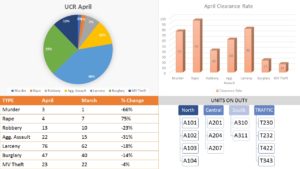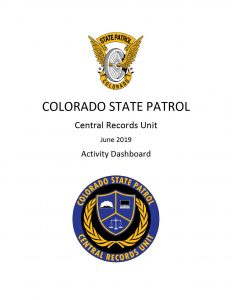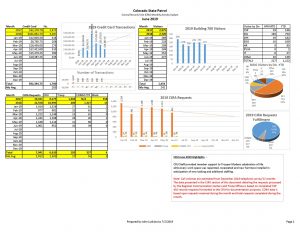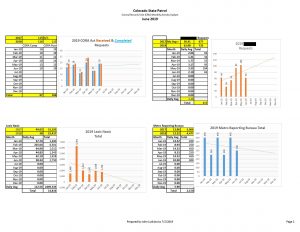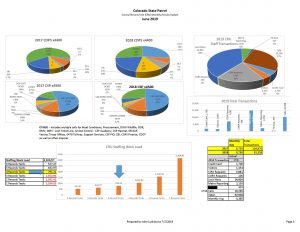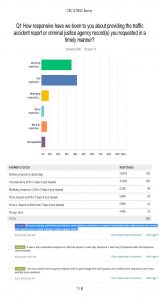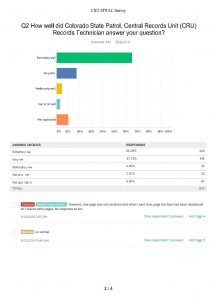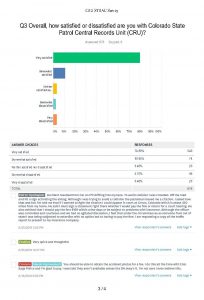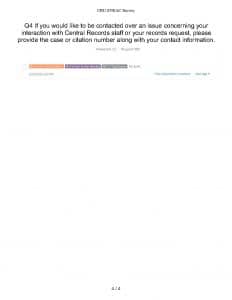September 2019
John Lynkiewicz, Records Manager
Colorado State Patrol
Often and unfortunately when it comes to resources, law enforcement records units do not fare well in the scramble for staffing or funding. Often because of the nature of what we do as a profession, it is overlooked and misunderstood as to its overall value and the impact a records unit provides to its customers, as we are not arresting criminals nor responding to emergency call. The efforts undertaken by our uniform and communication/dispatch staffs are well documented and published and well known by our leaders. Does your superior’s and executive command staff know what type of requests or services your unit responds to? What it produces? Its work product?
Most of the time what we do is assumed to be clerical in nature and is not well quantified for others to understand. A famous saying in project management is “You can’t define what you can’t measure and you can’t measure what you can’t define.” So what is important for your chain of command to know in order to make a well-educated decision concerning additional staffing, technology or resources for your unit?
Let’s start with the basics and define what you do and measure how much. Using a spread sheet program or other simple collection method, start tracking those things you do the most of. Take a look at what you and your staff are doing for most of their duty time. Is it records release, records redactions, answering the telephones, processing visitors into the building, dealing with concealed weapons permits, sex offenders?
Basic documentation of these activities can provide powerful insights to your unit’s activities. Let’s look at your work product; what do you produce? How many records do you release in a year? Does each record have to be reviewed for statutory reasons by one of your staff prior to release? How much time
does that take?
For example, in my agency, juvenile names are typically redacted prior to public release. How much time and effort is taken in the redaction of audio and video recordings? What is your average time involved in releasing a basic crash report? In our agency we document these activities and then take the information and create a monthly spreadsheet or dashboard for the chain of command to then have a visual document of the unit’s activities for the month and year. As you build this data, start tracking it in a weekly, monthly or yearly basis. It’s a great tool to measure your unit’s productivity.
At our agency, we collect information on the number of Criminal Justice Records Requests (CJRA), Colorado Open Records Act (CORA), the number of visitors my unit handles, as we are entry point for the various divisions of the Colorado Department of Public Safety (CDPS) main building. I can tell you on a monthly basis how many visitors are processed into the building, what divisions they are visiting. My dashboard indicates
- How many on-line requests are made for crash reports and the amounts collected.
- How many requests for records are processed here at the Central Records Unit versus Communication Centers or Troop Offices.
- We also answer the main telephone numbers for both the Colorado State Patrol and the Colorado Department of Public Safety. These calls are also tracked by conducting a survey for a set time period and are extrapolated into a year’s time.
- As a state patrol, we typically average over 30,000 crash investigations annually and as a result, track the various crash reporting service requests for these reports in the dashboard.
- We tally all the task items handled by the staff for the year, divide the total by number of Records Technicians available and it provides a pretty accurate measure of the amount of work accomplished. Of course, as staff leaves the unit, the average workload increases; when new staff completes training, the levels go down.
As part of a grant project, we were required to also provide a method of measurement of the unit’s level of customer service. We utilized Survey Monkey® as the collection tool and provide the monthly responses as part of the dashboard package. Using Excel® we then create the dashboard shown below that provides visual informational charts that highlight the activity level of the records unit.
Another thought- in the corporate world, the average employee works 2080 hours of paid time. If you take all the time that everyone on your staff has for vacation and sick time in totality, does it exceed 2080 hours? If so, then you in effect you are short one staff member each workday. Does this automatically justify an additional resource? Maybe, but you now have documentation of the issue along with the other work product outputs of your unit to take to management. In addition, it provides you as a supervisor, excellent measurement of employee performance levels.
Click on the images below (click back button when done).

